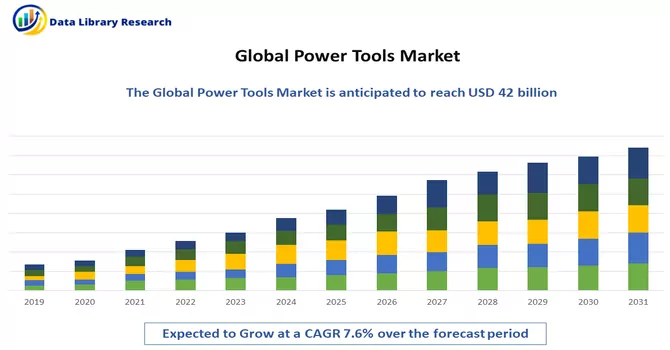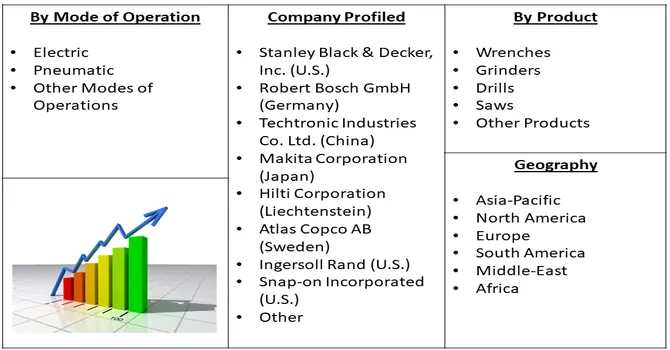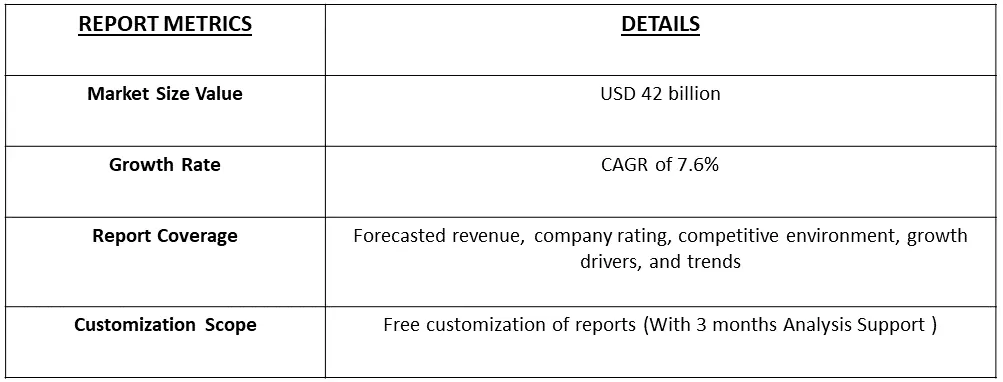The power tools market size was valued at USD 42 billion in 2023, which is expected to grow by registering a CAGR of about 7.6% during the forecast period, 2023-2031.

Get Complete Analysis Of The Report - Download Free Sample PDF
Power tools are mechanical devices or instruments that are powered by electricity, batteries, or compressed air to perform various tasks and operations. These tools are designed to provide additional power and efficiency compared to traditional hand tools, making it easier for users to complete tasks in construction, woodworking, metalworking, and other industrial or DIY applications. Power tools offer efficiency, speed, and precision, making them essential in various professional and DIY settings. Their versatility and ability to handle a wide range of tasks make them indispensable for tasks ranging from construction and carpentry to automotive repair and home improvement.
The ongoing trend of rapid industrialization and infrastructure development globally fuels the demand for power tools. Construction projects, manufacturing facilities, and infrastructure initiatives rely heavily on power tools for efficiency and precision. The growing popularity of DIY activities among consumers contributes significantly to the demand for power tools. Homeowners, hobbyists, and enthusiasts seek versatile and user-friendly power tools for various projects, ranging from woodworking to home repairs.
The market trends that are contributing to the studied market growth are the expansion of the construction industry, coupled with a surge in urbanization, which plays a pivotal role in driving the demand for power tools. Professionals in construction, carpentry, and related trades rely on these tools for their daily operations. Moreover, the growing emphasis on sustainability and energy efficiency prompts the development and adoption of energy-efficient power tools. Manufacturers and users alike are increasingly considering the environmental impact of power tool usage.
Market Segmentation: The Power Tools Market is segmented By Mode of Operation (Electric (Cordless, Corded), Pneumatic, Other Modes of Operations), By Product (Wrenches, Grinders, Drills, Saws, Other Products), By Region (North America, Europe, Asia-Pacific, Latin America, Middle East & Africa). The report offers market size and forecasts for the Power Tools Market in value (USD billion) for all the above segments.

For Detailed Market Segmentation - Download Free Sample PDF
Market Drivers :
Increasing Demand for Power Tools in the Automotive and Manufacturing Industries
The automotive and manufacturing industries have witnessed a substantial increase in the demand for power tools, driven by various factors that contribute to enhanced efficiency, precision, and productivity. Power tools play a crucial role in manufacturing processes, providing precision and efficiency in tasks such as cutting, drilling, and fastening. The use of power tools ensures accuracy and reduces manual labour, contributing to improved production outcomes. Automotive and manufacturing assembly lines heavily rely on power tools to streamline operations. Power drills, impact wrenches, and pneumatic tools expedite assembly processes, resulting in faster production cycles and increased throughput. Furthermore, the recent developments are expected to drive the growth of the studied market over the forecast period. For instance, in 2021, Stanley Black & Decker, Inc. forged a strategic partnership with Eastman to enhance sustainability in the power tools market. Under the umbrella of Stanley Black & Decker, the BLACK+DECKER brand unveiled an innovative product line named Reviva. This marks the introduction of the first sustainability-driven power tools brand, utilizing Eastman's Tritan Renew copolyester.
Growing Usage of Power Tools in Various Applications and Functionalities
Market Restraints :
High Costs Associated with Power Tools
Several challenges impede the growth of the power tools market. Key factors acting as significant constraints include the high maintenance costs associated with moving parts. The intricate nature of these components contributes to increased maintenance expenses, posing a challenge for both manufacturers and end-users within the market. Moreover, fluctuations in the prices of essential raw materials required for constructing power tools present another obstacle. The market is susceptible to variations in raw material costs, which can have a direct impact on production expenses. These fluctuations add a layer of uncertainty and can hinder the overall growth trajectory of the power tools market during the forecast period. Thus, the challenges of elevated maintenance costs and the volatility in raw material prices create hurdles for the sustained growth of the power tools market, necessitating strategic considerations and solutions within the industry.
The COVID-19 pandemic has significantly impacted the power tool market, introducing challenges and shifts in demand dynamics. The global power tool market experienced disruptions in the supply chain due to factory closures, transportation restrictions, and logistical challenges. This led to delays in the production and distribution of power tools, affecting manufacturers and suppliers. The lockdowns and social distancing measures implemented worldwide resulted in a slowdown or suspension of construction and industrial activities. With many construction projects halted and manufacturing facilities operating at limited capacity, the demand for power tools in these sectors saw a notable decline. As economies began to recover, there was a gradual resurgence in construction and industrial activities, contributing to the rebound of the power tool market. However, the pace of recovery varied across regions, depending on the effectiveness of pandemic containment measures. Thus, the COVID-19 pandemic disrupted the power tool market, leading to supply chain challenges, changes in consumer behaviour, and shifts in demand patterns. The industry demonstrated resilience and adaptability, with recovery contingent on global efforts to overcome the ongoing challenges posed by the pandemic.
Segmental Analysis:
Cordless Mode of Operation Segmentation is Expected to Witness Significant Growth Over the Forecast Period
The cordless mode of operation has revolutionized the power tools industry, providing users with enhanced flexibility, mobility, and convenience. This advancement in technology has significantly impacted the design and functionality of power tools across various applications Cordless power tools eliminate the need for a constant power source, allowing users to move freely without being tethered to electrical outlets. This enhances mobility and portability, making cordless tools ideal for applications where manoeuvrability is crucial. Cordless power tools are particularly advantageous for outdoor applications, such as construction sites, landscaping, and remote job sites. Users can work in environments where access to electrical outlets may be limited. Thus, owing to such benefits, the segment is expected to witness significant growth over the forecast period.
Grinders Segmentation is Expected to Witness Significant Growth Over the Forecast Period
Grinders are an essential category of power tools that find widespread use in various industries and applications. These versatile tools are designed for material removal, shaping, and finishing tasks, making them indispensable in metalworking, construction, woodworking, and other related fields. These handheld grinders feature a rotating abrasive disc and are commonly used for cutting, grinding, and polishing tasks. They are versatile and suitable for applications ranging from metal fabrication to masonry work. Stationary tools with abrasive wheels mounted on a bench or pedestal. Bench grinders are ideal for precision tasks like sharpening blades, shaping metals, and polishing. Grinders accommodate a variety of abrasive discs, allowing users to choose the appropriate tool for the specific task. This includes grinding wheels, cutting discs, wire brushes, and sanding discs. Thus, owing to such benefits, the segment is expected to witness significant growth over the forecast period.
North America Region is Expected to Witness Significant Growth Over the Forecast Period
North America is a significant market for power tools, with a robust industrial sector, a thriving construction industry, and a large base of do-it-yourself (DIY) enthusiasts contributing to the demand for various types of power tools. The industrial sector in North America relies heavily on power tools for manufacturing processes. Industries such as automotive, aerospace, electronics, and machinery manufacturing use a diverse range of power tools for tasks like cutting, shaping, fastening, and assembly. The market for power tool repairs and replacements is notable in North America. Many consumers prefer repairing their existing tools, contributing to a secondary market for replacement parts and services.
Furthermore, the developments in the region are propelling the growth of the studied market over the forecast period. For instance, in 2021, Robert Bosch Power Tools GmbH announced the growth of its comprehensive product line of wood cutting and woodworking solutions with the launch of its 18V and 12V cordless sanders. This cordless sander is designed for convenience and optimal balance. Thus, such factors are expected to drive the growth of the studied market over the forecast period.
Thus, North America represents a dynamic and evolving market for power tools, driven by industrial activities, construction projects, a vibrant DIY culture, and a continuous focus on innovation and safety. The region's power tools market is expected to remain resilient with ongoing technological advancements and a diverse range of applications across various sectors.

Get Complete Analysis Of The Report - Download Free Sample PDF
The competitive landscape of the power tools market encompasses comprehensive details about the industry's key players. This information includes an overview of each company, its financial performance, revenue generation, market potential, investment in research and development, initiatives in new markets, global reach, production sites and facilities, production capacities, strengths and weaknesses, product launches, product diversity, and dominance in various applications. It is important to note that the mentioned data points specifically pertain to each company's strategic focus within the power tools market. This thorough analysis provides insights into the competitive dynamics and strategic positioning of key players in the power tools industry. Some of the major players operating in the power tools market are:
Recent Developments:
1) In March 2023, DEWALT, a prominent brand under Stanley Black & Decker, unveiled an expansion of its TOUGHSYSTEM® 2.0 storage line, introducing three innovative products to enhance user experience. The newly introduced products include an Adaptor, Deep Compact Toolbox, and 3-drawer Toolbox, collectively providing users with enhanced connectivity to other storage modules and convenient accessibility to their tools. Notably, the TOUGHSYSTEM® 2.0 Adaptor (DWST08017) empowers users to construct a versatile and tailored storage solution by offering expanded compatibility with other modules.
2) In March 2023, Hilti, a leading player in the construction industry, announced a strategic partnership with Canvas, a cutting-edge construction robotics company specializing in robotic drywalling solutions. This collaboration signifies a shared vision between the two industry leaders: the belief that robotic tools have the potential to unlock unprecedented opportunities and usher in a new era of productivity and safety for skilled trade workers. The partnership aims to leverage the expertise of both companies in intelligent jobsite robotics, showcasing a commitment to advancing technology in the construction sector and empowering workers to embrace innovative and efficient building practices.
Q1. What was the Power Tools Market size in 2023?
As per Data Library Research the power tools market size was valued at USD 42 billion in 2023.
Q2. At what CAGR is the Power Tools market projected to grow within the forecast period?
Power Tools Market is expected to grow by registering a CAGR of about 7.6% during the forecast period.
Q3. What are the factors driving the Power Tools market?
Key factors that are driving the growth include the Increasing Demand for Power Tools in the Automotive and Manufacturing Industries and Growing Usage of Power Tools in Various Applications and Functionalities.
Q4. Which region has the largest share of the Power Tools market? What are the largest region's market size and growth rate?
North America has the largest share of the market. For detailed insights on the largest region's market size and growth rate request a sample here.
Data Library Research are conducted by industry experts who offer insight on industry structure, market segmentations technology assessment and competitive landscape (CL), and penetration, as well as on emerging trends. Their analysis is based on primary interviews (~ 80%) and secondary research (~ 20%) as well as years of professional expertise in their respective industries. Adding to this, by analysing historical trends and current market positions, our analysts predict where the market will be headed for the next five years. Furthermore, the varying trends of segment & categories geographically presented are also studied and the estimated based on the primary & secondary research.
In this particular report from the supply side Data Library Research has conducted primary surveys (interviews) with the key level executives (VP, CEO’s, Marketing Director, Business Development Manager and SOFT) of the companies that active & prominent as well as the midsized organization
FIGURE 1: DLR RESEARH PROCESS

Extensive primary research was conducted to gain a deeper insight of the market and industry performance. The analysis is based on both primary and secondary research as well as years of professional expertise in the respective industries.
In addition to analysing current and historical trends, our analysts predict where the market is headed over the next five years.
It varies by segment for these categories geographically presented in the list of market tables. Speaking about this particular report we have conducted primary surveys (interviews) with the key level executives (VP, CEO’s, Marketing Director, Business Development Manager and many more) of the major players active in the market.
Secondary ResearchSecondary research was mainly used to collect and identify information useful for the extensive, technical, market-oriented, and Friend’s study of the Global Extra Neutral Alcohol. It was also used to obtain key information about major players, market classification and segmentation according to the industry trends, geographical markets, and developments related to the market and technology perspectives. For this study, analysts have gathered information from various credible sources, such as annual reports, sec filings, journals, white papers, SOFT presentations, and company web sites.
Market Size EstimationBoth, top-down and bottom-up approaches were used to estimate and validate the size of the Global market and to estimate the size of various other dependent submarkets in the overall Extra Neutral Alcohol. The key players in the market were identified through secondary research and their market contributions in the respective geographies were determined through primary and secondary research.
Forecast Model
